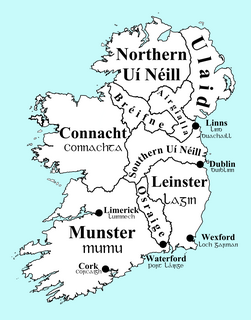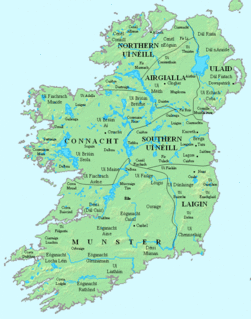Conall mac Suibni (died 635), called Conall Guthbinn, Prince of Meath, was King of Uisnech in Mide of the Clann Cholmáin. He was the son of Suibne mac Colmáin (died 600), a previous king. [1] He ruled from 621 to 635. [2] His byname Guthbinn meant "sweet voiced".

Meath was a kingdom in Ireland for over 1000 years. Its name means "middle," denoting its location in the middle of the island.

Clann Cholmáin is the dynasty descended from Colmán Már, son of Diarmait mac Cerbaill. Part of the Southern Uí Néill — they were the kings of Mide (Meath) — they traced their descent to Niall Noígiallach and his son Conall Cremthainne.
Suibne mac Colmáin was a King of Uisnech in Mide of the Clann Cholmáin. He was the son of Colmán Már mac Diarmato, also King of Uisnech. He ruled Uisnech from 587 to 600.
His father Suibne had been killed in 600 by his uncle Áed Sláine mac Diarmato (died 604) eponymous ancestor of the Síl nÁedo Sláine. [3] This set off a feud between the Clann Cholmáin and Síl nÁedo Sláine and in 604 a battle was fought in Faithche Mic Mencnain on the shore of Loch Semdid (Lough Sewdy), (Ballymore Loughsewdy in modern County Westmeath). [4] During the battle Conall saw his foster brother Áed Gustan slaying Áed Sláine. Áed Rón of the Uí Failge and Áed Buide, king of Tebtha, Áed Sláine's allies, were also slain. [5]
Áed mac Diarmato, called Áed Sláine, was the son of Diarmait mac Cerbaill. Legendary stories exist of Áed's birth. Saint Columba is said to have prophesied his death. His descendants, the Síl nÁedo Sláine—the seed of Áed of Slane—were prominent in 7th and early 8th century Ireland.

An eponym is a person, place, or thing after whom or after which something is named, or believed to be named. The adjectives derived from eponym include eponymous and eponymic. For example, Elizabeth I of England is the eponym of the Elizabethan era, and "the eponymous founder of the Ford Motor Company" refers to Henry Ford. Recent usage, especially in the recorded-music industry, also allows eponymous to mean "named after its central character or creator".
Síl nÁedo Sláine[ˈsʲiːlʲ ˈnaiðo ˈslaːnʲe] are the descendants of Áed Sláine, son of Diarmait mac Cerbaill. Part of the Southern Uí Néill—they were the kings of Brega—they claimed descent from Niall Noígiallach and his son Conall Cremthainne.
The Annals of Ulster record:
It was no time when counsel prevailed, for the warriors beyond Tuirbe: Conall slew Áed of Sláine, Áed Sláine slew Suibne. [6]
Conall succeeded as King of Uisnech in 621 on the death of Óengus mac Colmáin, son of Colmán Bec. [7] In 622, during the Battle of Cenn Deilgthen (modern Kildalkey in County Meath), [8] Conall defeated a rival faction of cousins led by two sons of Librén, son of Illand, son of Cerball. Illand was the brother of Conall's great-grandfather the high king Diarmait mac Cerbaill (died 565). Domnall Brecc (died 642), later king of Dál Riata fought alongside Conall. [9]
Óengus mac Colmáin Bec was an Irish king. He was the King of Uisnech in Mide from 618 to 621. He belonged to the southern Uí Néill. According to the genealogies, he was a son of Colmán Bec, son of Diarmait mac Cerbaill. The later Caílle Follamain traced their descent through Óengus.

Kildalkey or Kildalky is a village and a parish in the Barony of Lune, county and diocese of Meath, Ireland.
In 633, at the Battle of Áth Goan, west of the Liffey, Conall allied with Faílbe Flann mac Áedo Duib (died 637), the king of Munster, to assist Fáelán mac Colmáin (died 666?) of the Uí Dúnlainge in defeating and slaying Crimthann mac Áedo of the Uí Máil, acquiring the throne of Leinster. The Clann Cholmain assisted the Ui Dunlainge in their rise to power, neutralizing the border situation with the Ui Failgi, as the Ui Dunlainge carried out their rivalry with the Síl nÁedo Sláine. Fáelán mac Colmáin married Conall's sister Uasal ingen Suibni (died 643). [10]

The River Liffey is a river in Ireland, which flows through the centre of Dublin. Its major tributaries include the River Dodder, the River Poddle and the River Camac. The river supplies much of Dublin's water and a range of recreational activities.
Faílbe Flann mac Áedo Duib was a King of Munster from the Eóganacht Chaisil branch of the Eoganachta. He succeeded Cathal mac Áedo Flaind Chathrach of the Glendamnach branch in 628. He was the younger brother of a previous king Fíngen mac Áedo Duib. His sobriquet Flann meant "blood-red".
Fáelán mac Colmáin was a King of Leinster from the Uí Dúnlainge branch of the Laigin. He was the son of Colmán Már mac Coirpri, a previous king. Faelan was the founder of the true fortunes of the Ui Dunlainge dynasty.
In 634, at the Battle of Loch Trethin at Fremainn (Lough Drin, .75 miles northeast of Cullionbeg, County Westmeath), [11] [12] Conall slew Congal mac Áedo Sláine, King of Brega, and his brother Ailill Cruitire, continuing the feud with the Síl nÁedo Sláine. In 635 Diarmait mac Áedo Sláine (died 665) killed Conall in the house of Nad Fraích's son. [13]
Congal mac Áedo Sláine was a King of Brega from the Síl nÁedo Sláine branch of the southern Ui Neill. He was the son of the high king Áed Sláine mac Diarmato.
The Kings of Brega were rulers of Brega, a petty kingdom north of Dublin in medieval Ireland.
Ailill Cruitire mac Áedo Sláine was a King of Brega from the Síl nÁedo Sláine branch of the southern Ui Neill. He was the son of the high king Áed Sláine mac Diarmato. His byname meant "harper".
Conall's son Airmetach Cáech was slain at the Battle of Mag Rath (modern day Moira, County Down) [14] in 637 fighting for Congal Cáech of Ulaid and against the High King Domnall mac Áedo (died 642) of the Cenél Conaill. Airmetach's son Fáelchú was also slain in this battle. [15] Airmetach's other son, Diarmait Dian mac Airmetaig Cáech (died 689), was a King of Uisnech.
Congal Cáech was a king of the Cruthin of Dál nAraidi in the medieval Irish province of Ulaid, from around 626 to 637. He was king of Ulaid from 627–637 and, according to some sources, High King of Ireland.

Ulaid or Ulaidh ) was a Gaelic over-kingdom in north-eastern Ireland during the Middle Ages, made up of a confederation of dynastic groups. Alternative names include Ulidia, which is the Latin form of Ulaid, as well as in Cóiced, which in Irish means "the Fifth". The king of Ulaid was called the rí Ulad or rí in Chóicid.
Domnall mac Áedo, also known as Domnall II, was a son of Áed mac Ainmuirech. Domnall was High King of Ireland from 628 until his death. He belonged to the Cenél Conaill kindred of the Northern Uí Néill.
